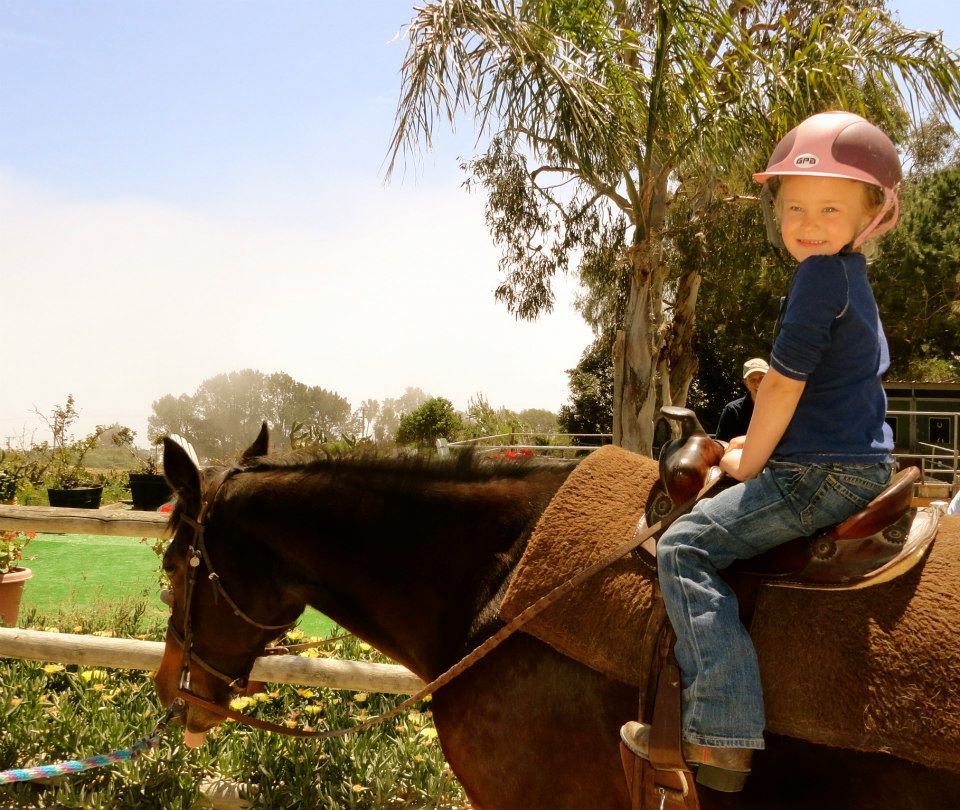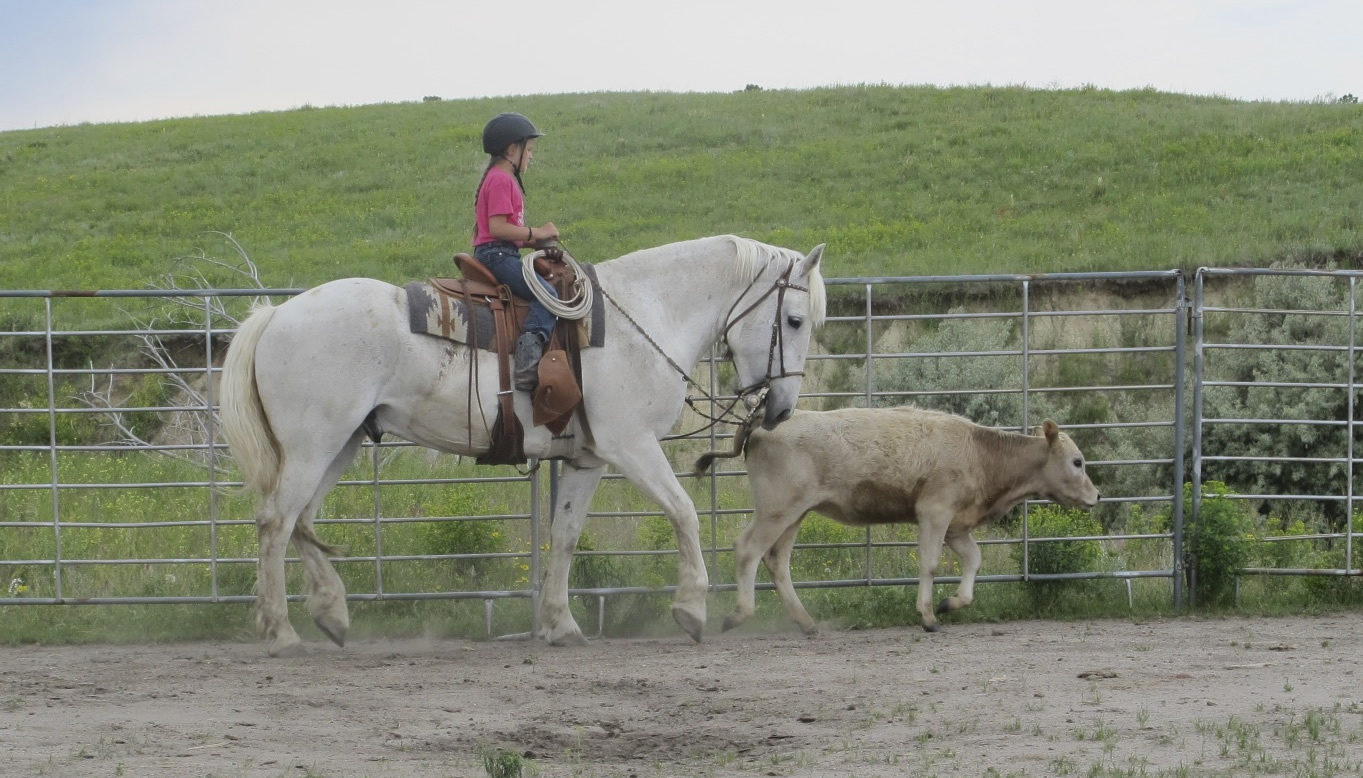Parents often ask me at what age their children will be ready for riding lessons. In short, my answer is, “there’s no perfect age: I watch for signs of readiness.” Even though a child may be giddy to start riding horses, they may not be truly ready to engage with them.
There are several developmental skills required for success with horses. Readiness for horse activities does not come on a certain birthday, and can vary from child to child. Furthermore, just because a program offers children’s lessons does not mean that your child will be physically and psychologically ready for lessons. While many parents feel that putting their child in riding lessons early is the best thing for them, much of the research suggests that pushing an early start can actually be detrimental, causing undesired physical and emotional consequences for both the student and the horse.
Another concern with children who get an early start is burnout. Burnout can happen when a child gets physically or emotionally drained and loses interest. This often happens if their lessons and teachers place emphasis on extrinsic rewards, such as shows and ribbons. Emphasis on extrinsic rewards can ultimately decrease intrinsic motivation for a child. A great children’s teacher will focus on the joy of learning and helping the child develop a relationship with their horse. A negative early experience can last a lifetime, so I recommend testing a few markers of readiness before enrolling your child in lessons.
Taking direction – The ability to take direction from someone other than a parent is extremely important. Your child’s experience in school and other learning environments will be the best indicator as to how well they take direction. How well does your child listen and respond to his or her teachers? Play activities are also a good way to evaluate a child’s ability to take direction. Can your child learn a new task from a sibling or babysitter? Can your child engage in group-play with another child as a leader or teammate? Due to the nature of horseback riding, it is also important that your child is comfortable in a lesson situation where their parent may not be in the same room. When riding a horse it’s paramount for children to be able to listen to and follow directions given by their instructor.
Addressing the following questions will help determine your child’s readiness for riding lessons.
When will my child be ready for equestrian activities?
Each child develops at his or her own pace, but they will all pass through the same developmental stages. A child will be ready for an introduction to horses when he or she is physically, cognitively, and emotionally ready.
Physical readiness:
 A child displays physical readiness once their body can meet the physical demands of engaging with a horse. While physical readiness can lead to emotional confidence with horses, over-tasking a child that is unable to physically handle a living, breathing, decision making large animal can have detrimental physical and emotional consequences that can last a lifetime. Before working with horses he or she will need to have stamina, endurance, and muscular strength for specific riding and horsemanship skills. Examples of these skills include the abilities to lead, tie, and groom a thousand pound equine, as well as sitting balanced in a saddle and using various muscle groups in isolation. For instance they will use their legs to ask their horse to walk forward (gross motor skill) while keeping their arms soft (i.e., not clenched) and hands “quiet” (fine motor skill) so as not to jerk or pull backward on the reins. A child that has acquired the physical ability to ride a bike, for example, can transfer the skills of successfully steering and pedaling as it relates to horses. Look for markers of physical strength and stamina in your child’s other activities to assess physical readiness. Things like skipping and independent foot/side-to-side motions a helpful, as is being able to differentiate and isolate right vs. left sided movements.
A child displays physical readiness once their body can meet the physical demands of engaging with a horse. While physical readiness can lead to emotional confidence with horses, over-tasking a child that is unable to physically handle a living, breathing, decision making large animal can have detrimental physical and emotional consequences that can last a lifetime. Before working with horses he or she will need to have stamina, endurance, and muscular strength for specific riding and horsemanship skills. Examples of these skills include the abilities to lead, tie, and groom a thousand pound equine, as well as sitting balanced in a saddle and using various muscle groups in isolation. For instance they will use their legs to ask their horse to walk forward (gross motor skill) while keeping their arms soft (i.e., not clenched) and hands “quiet” (fine motor skill) so as not to jerk or pull backward on the reins. A child that has acquired the physical ability to ride a bike, for example, can transfer the skills of successfully steering and pedaling as it relates to horses. Look for markers of physical strength and stamina in your child’s other activities to assess physical readiness. Things like skipping and independent foot/side-to-side motions a helpful, as is being able to differentiate and isolate right vs. left sided movements.
Cognitive readiness:
Attention span —Attention span is crucial for anyone, young or old, in a lesson environment. A riding lesson averages one hour. A quality children’s instructor will give breaks to help reward focus by stopping and allowing the child to talk or relax after small attainable goals have been accomplished, but a child still needs the ability to focus well. Working with a half-ton animal is no easy feat, and can be dangerous if one isn’t focused and mindful.
To gauge your child’s readiness via focus, notice your child’s attention span during various types of activities (e.g., physical activities, focusing on a puzzle, listening to directions, and following through). Parents can model good focusing behavior by showing children how to listen well. Have a conversation with your child. Keep your eyes on them and signal that you want their undivided attention. Say things like, “I’m going to start talking. Show me what attention looks like.” See how long your child can keep their eyes on you while you share a short story with them, or describe a task you want them to complete. If these types of exercises are successful, your child may have the attention span needed to begin riding lessons.
Emotional readiness:
 Children who are emotionally ready to work with horses tend to be brave, somewhat independent, and able to take direction. The one thing that will bolster these traits is a sincere desire to work with horses. If the push for riding lessons comes from the parent or someone other than the child, this could hinder their entire experience, turning them off to the joys of learning from horses for the rest of their lives. When beginning lessons for the first time, the lines of communication must remain open to ensure that the child’s needs are being met, they are still enthusiastically interested in riding horses, and their confidence is building.
Children who are emotionally ready to work with horses tend to be brave, somewhat independent, and able to take direction. The one thing that will bolster these traits is a sincere desire to work with horses. If the push for riding lessons comes from the parent or someone other than the child, this could hinder their entire experience, turning them off to the joys of learning from horses for the rest of their lives. When beginning lessons for the first time, the lines of communication must remain open to ensure that the child’s needs are being met, they are still enthusiastically interested in riding horses, and their confidence is building.
When children display each of these signs of readiness they are able to have successful and exciting interactions with horses. They understand and respect that horses are living, breathing, thinking beings. With proper instruction and a safe environment, a child’s physical, cognitive, and emotional maturity will set a foundation for a bright future with their equine partners.


